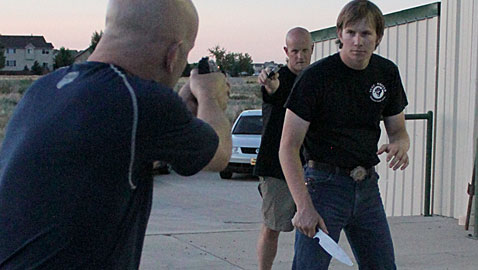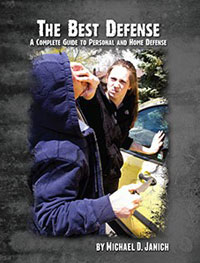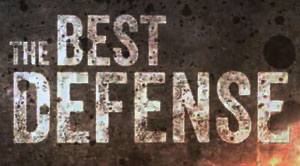Widgetized Section
Go to Admin » Appearance » Widgets » and move Gabfire Widget: Social into that MastheadOverlay zone
Outnumbered And Alone: The Logic Of Facing Multiple Attackers
 Like many predators, criminals often operate in packs. Sound self-defense tactics should therefore need to consider the likelihood of facing multiple attackers. Although the “Motorcycle Attack” episode of season 7 of The Best Defense focused on unarmed tactics against multiple attackers to “earn” the draw of a handgun, once the gun is out there are still many ways to approach the problem of facing more than one attacker.
Like many predators, criminals often operate in packs. Sound self-defense tactics should therefore need to consider the likelihood of facing multiple attackers. Although the “Motorcycle Attack” episode of season 7 of The Best Defense focused on unarmed tactics against multiple attackers to “earn” the draw of a handgun, once the gun is out there are still many ways to approach the problem of facing more than one attacker.
From a shooter’s perspective, there are many different philosophies as to the best way to engage multiple attackers. Traditionalists who devoted lots practice to drills like the El Presidente prefer putting two rounds into each target, reloading and repeating. Others advocate one round per target, assessing the results, and repeating as necessary. Still others argue the logic of engaging attackers from closest to farthest or in the order of most dangerous to least dangerous.
Wargaming the logic of these various approaches is a good thing; but unfortunately some have taken the process to extremes, conjuring up elaborate scenarios in which multiple assailants are positioned at various distances and armed with a an entire spectrum of rifles, shotguns, handguns, and contact-distance weapons. The supposed goal is to prioritize them based on the threat they pose to you and address them in the “right” order. In my opinion, the result of this process is more often a prolonged “gun-guy” debate or an overly complicated square range drill than worthwhile training that promotes sound tactical judgment.
Reality Rules
In any real self-defense situation where you choose to draw a firearm, you should be doing so only because you were in fear for your life or in fear of serious injury—or you were doing so to protect another innocent party against similar grave threats of violence. In those circumstances, you must know why you drawing, so the threat (or threats) should be self-apparent.
To illustrate this point, let’s consider a simple scenario involving two attackers—one armed with a handgun and one with a knife. Let’s also consider two training methodologies—a traditional square-range shooting method and a more interactive but non-shooting drill involving you, two friends, blue-gun o airsoft pistols and a training knife.
First, imagine setting up a range drill with two targets downrange at distances of 3 and 5 yards and a lateral spread of about two yards. It doesn’t really matter which target is on which side or at what distance. Now, with eyes and ears on and proper attention to range safety face the targets with your holstered gun and have a shooting partner call “go.” Which targets do you shoot and in which order? To many shooters, the possible answers would be fodder for a spirited debate or a lengthy thread on an internet forum. In reality, however, you’d only be justified in shooting the pistol-armed target. Why? Because the target with a knife isn’t a lethal threat at that distance.
Article continues below…
![]()
 |
THE BEST DEFENSEA Complete Guide To Personal And Home Defense
by Michael D. Janich, co-host of the hit TV series “The Best Defense”
|
![]()
Now, set up the same drill with your two training partners—one armed with a blue gun and the other a training knife. Arm yourself with a holstered blue gun. Now, slowly work through all the possible scenarios. Regardless of whether the gun-armed attacker starts at 3 or 5 yards, if he raises his gun toward you, he has established himself as a potentially lethal threat and becomes a top priority. If, while you’re shooting at him, the knife-armed attacker charges toward you, you probably won’t ignore his attack while you fire additional rounds into his pistol-armed buddy, so your focus would naturally shift to him and the goal of not getting stabbed.
On the other hand, if the knife-armed attacker stays at a distance growling and cursing at you, but never actually moves toward you, he never actually establishes himself as a potentially lethal threat. Legally, you can’t shoot him. And, since the knife-armed target in the range scenario never got close enough to be a tangible threat, you shouldn’t have shot it either.
The real learning point here is not arguing to determine the ultimate “right” answer, but to understand the dramatic difference between a dynamic, interactive scenario and a range drill that emphasizes marksmanship and the mechanics of shooting more than sound reactive judgment. On one hand, this contrast makes the problem of multiple attackers incredibly complicated. Instead of focusing on the skills of delivering accurate fire and transitioning smoothly from one target to another, it requires you to react to multiple, dynamic stimuli with immediate judgment and both shooting and non-shooting skill. If you think about it, however, it also greatly simplifies the problem of prioritizing threats because the threats and their immediate ability and opportunity to target you become self-evident.
Basic Principles
In my opinion, there is no one-size-fits-all strategy for dealing with multiple attackers because the variables involved are simply too numerous. However, there are a few key principles that you can employ that can improve your survivability in most situations—specifically, movement and “stacking” your attackers.
Movement offers several advantages against multiple attackers. First, a moving target is more difficult to hit than a stationary one. Regardless of whether your attackers are armed with firearms or contact weapons, you’re going to be more difficult to hit if you are moving than if you try to stand tall and sling lead.
Proper movement allows you to change the dynamics of your situation and make the best use of your environment. If you are caught out in the open, movement toward cover can obviously improve your survivability against gunfire. Against attackers armed with contact-distance weapons, movement toward or around obstacles can also limit their ability to target you effectively by denying them straight-line access to you.
Movement is also critically important to employing the second principle—“stacking.” Stacking is basically moving so that, from your perspective, you put your attackers in a single line. For example, if you’re facing two attackers laterally spread in front of you, you would move off at an angle until, from your perspective, you see one behind the other. Done properly, this not only keeps them from surrounding you, it forces them to engage you one at a time instead of simultaneously. It also simplifies your shooting problem by putting all your targets in one lane. In the process, the attacker(s) at the rear of the line serve as backstops for your shots at the one in the front and the first attacker becomes your cover against the attacker(s) in the rear.
Which Way?
The direction you choose to move will always be very dependent upon the environment and your awareness of it. However, in general terms, moving to your right can offer some significant advantages. Since most people are right handed, moving to your right makes it harder for an attacker to hit you with a hand-wielded weapon because he has to swing it across his body to reach you. Moving in an arc around him makes you even harder to hit.
Moving to the right also allows you to maintain a guard or fend with your left hand (assuming you’re also a righty) as you draw your gun on the move. Once your gun is out, movement to your right enables you to use a two-handed shooting platform—basically a Weaver stance shooting to your left—as you move, affording you greater control and accuracy than shooting one handed.
Facing multiple attackers is a frightening prospect and having the skills to do it effectively requires good training and tactics. Rather than agonizing over whether you should shoot the guy with the RPG or the guy with the chainsaw first, remember that you will be shooting for an obvious reason. The clarity of that reason should greatly simplify your thought process.
Train hard, stay safe.
Mike
About Michael Janich:
 Michael Janich is the co-host of The Best Defense and a noted personal-defense instructor, author of numerous books and instructional videos, and founder of the Martial Blade Concepts (MBC) system of edged-weapon tactics. A decorated U.S. Army veteran, Defense Intelligence Agency (DIA) intelligence officer, and former POW/MIA investigation team leader, Janich is also one of the most accomplished videographers in the tactical industry. He is currently the Special Projects Coordinator for the Spyderco knife company and a partner in Stay Safe Media.
Michael Janich is the co-host of The Best Defense and a noted personal-defense instructor, author of numerous books and instructional videos, and founder of the Martial Blade Concepts (MBC) system of edged-weapon tactics. A decorated U.S. Army veteran, Defense Intelligence Agency (DIA) intelligence officer, and former POW/MIA investigation team leader, Janich is also one of the most accomplished videographers in the tactical industry. He is currently the Special Projects Coordinator for the Spyderco knife company and a partner in Stay Safe Media.
To train with Janich and learn more about his classes, click here….






 MidwayUSA
MidwayUSA Ruger Firearms
Ruger Firearms SCCY Firearms
SCCY Firearms Streamlight
Streamlight Action Targets
Action Targets Gunsite Academy
Gunsite Academy
You must be logged in to post a comment Login